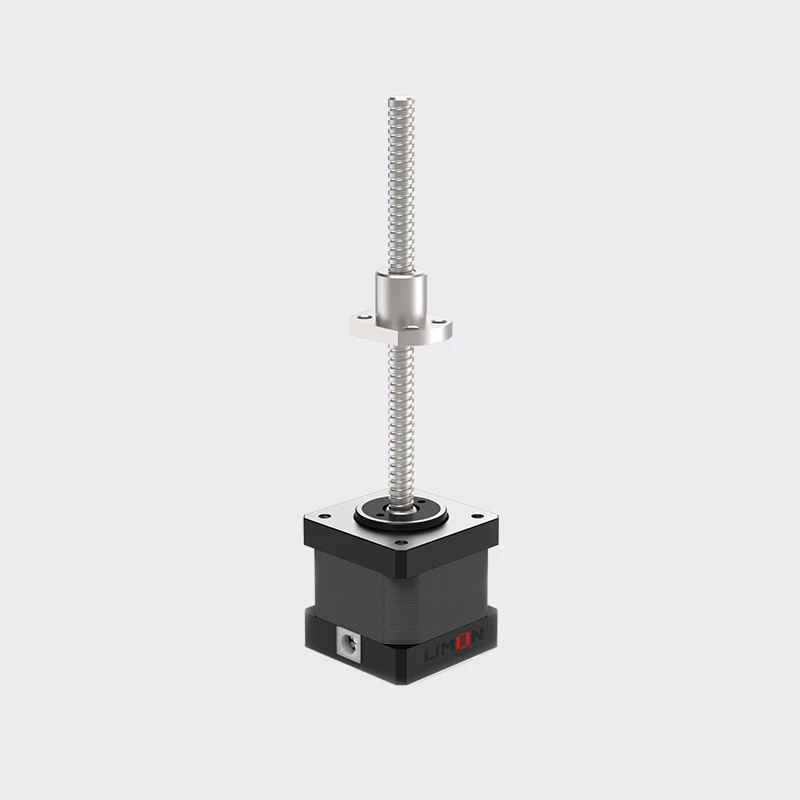Get In Touch
Welcome to discuss your purchasing requirements with our customer service.
The basic principle of linear stepper motor: using a screw and nut meshing, take some way to prevent the relative rotation of the screw nut, so that the screw axial movement. Generally speaking, there are two ways to achieve this transformation at present. The first way is to build a rotor with internal thread in the motor to achieve linear motion with the internal thread of the rotor meshing with the screw. The second way is to use the screw as the shaft of the motor to achieve linear motion through an external drive nut meshing with the screw outside the motor. Therefore, the design has been greatly simplified, making it possible in many applications to use linear stepper motors directly for precise linear motion without the installation of external mechanical linkages.

Like most linear motors, a linear stepper motor is essentially a variation of the rotary design, cut radially and laid out flat. Similar to their rotary counterparts in operation and performance, linear stepper motors are typically run as open-loop systems and are capable of providing high feedback at high speeds and accelerations. The linear stepper motor almost exclusively employs a hybrid design, with two main parts.One base and another is slider. Unlike other linear motor designs, in a linear stepper motor, the platen is a passive component. The forcer contains laminations with slotted teeth, motor windings, and a permanent magnet. The teeth of the forcer concentrate the magnetic flux that is created when current is applied to the coils. The forcer teeth are also staggered in relation to the platen teeth—typically by ¼ tooth pitch—to ensure that constant attraction is maintained and that the next set of teeth will come into alignment as current is switched in the coils. For each full step of the motor, the forcer moves ¼ tooth pitch.
● Wide range of feed speed. It can be from 1m/s to more than 20m/min, and the fast forward speed of the machining center has reached 208m/min, while the traditional machine tool fast forward speed is less than 60m/min, generally 20 ~ 30m/min.
● Performance speed characteristics. The velocity deviation can be less than (1) 0.01%.
● High acceleration. The maximum acceleration of linear stepper motor can reach 30g, the feed acceleration of machining center has reached 3.24g, the feed acceleration of laser processing machine has reached 5g, and the feed acceleration of traditional machine tools is below 1g, generally 0.3g.
● High positioning accuracy. Using grating closed-loop control, the positioning accuracy can reach 0.1 ~ 0.01 (1) mm. The linear motor drive system with feed forward control can reduce the tracking error by more than 200 times. Because of the good dynamic characteristics of the moving parts, sensitive response, and the precision of interpolation control, it can realize the nanoscale control.
● And etc.
stepper motor linear actuator is an ideal high positioning precision instrument which can be developed and applied widely. The hybrid stepper motor linear actuator is a simple improvement. It has been widely used in the fields of computer equipment application, CNC machine tools, automatic plotter, robot development and transmission equipment detection and control. Especially in recent years, the rapid development of microelectronic devices and interface technology, promote the stepper motor linear actuator automation and intelligence and highly integrated cost is greatly reduced, and in the field of aerospace has a very large development potential and wide range of promotion prospects.
Besides, stepper motor linear actuator also be widely used in paper calibration, fluid measurement, position movement industry and etc. Typical applications include X-Y workbench, medical equipment, semiconductor equipment, environmental protection equipment, automatic robots, 3D printers, etc.